Built on Hustle
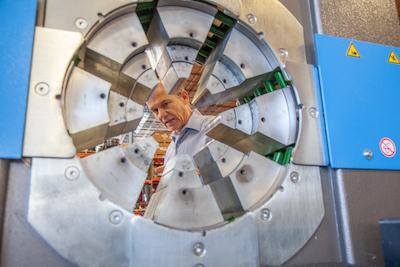 |
|
Dave Heckler, president of |
EFFICIENCY IS THE NAME OF THE GAME AT ALLIANCE HOSE & RUBBER
by Kim Phelan
Far at the back of the 50,000-sq.-ft. warehouse at Alliance Hose, past tall rows of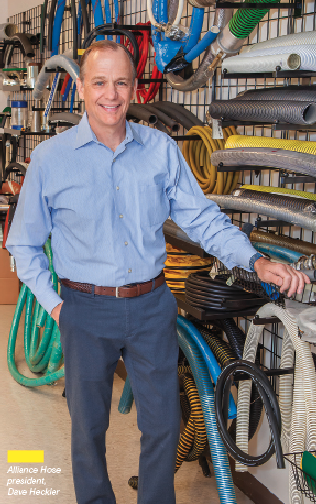 bright colored inventory and beyond the central production area, a worn yellow measuring decal marks out 100 feet across the shop floor. Its faded numbers tell a story of thousands of yards of hose material that have been cut to size and processed for customers since the 90-year-old distribution company moved to its Elmhurst, Illinois, location in 2013. If that line could really speak, it would also tally the high measure of innovation, leadership, and respect for team that trickle from the top at this third-generation, family-owned business.
bright colored inventory and beyond the central production area, a worn yellow measuring decal marks out 100 feet across the shop floor. Its faded numbers tell a story of thousands of yards of hose material that have been cut to size and processed for customers since the 90-year-old distribution company moved to its Elmhurst, Illinois, location in 2013. If that line could really speak, it would also tally the high measure of innovation, leadership, and respect for team that trickle from the top at this third-generation, family-owned business.
President Dave Heckler keeps a lot of spinning plates whirring with a seemingly effortless style and down-to-earth demeanor, but don’t be deceived by his soft-spoken manner and occasional pithy pun – he’s a serial doer. Making continuous improvements and investments, maximizing shop efficiency, and managing through explosive growth for each of the last two years, Heckler also puts heavy emphasis on building people up and trusting them with decision-making. In fact, he can’t talk about their near-doubled inventory and tripled backlog since 2021 without praising the employees who deftly handled it.
“I’m really proud of what our people have done to respond to such a dramatic increase in volume over the past two years,” he said. “There was a lot of overtime, a lot of Saturdays in production. We even had people come in on a “swing shift” a handful of times due to tight floor space and the need to keep production flowing.”
It’s plain to see why he says his business is built on hustle. The operation, though highly manual for many production functions, is teeming with progressive practices. The entire sales team has embraced use of the company’s CRM, and gets as much back from its use as the company receives in sales results. Alliance has also been paperless in production for about eight years, Heckler said, and the tools and processes the team employs are tightly focused on improving speed of delivery and value-add service. One such tool is a completely novel machine, and Heckler says he’s probably the only distributor in the country – maybe the world – who has it. Custom-built for Alliance and not commercially available, the machine heats the end of a hose to make it pliable before fittings are attached. Instead of a few minutes of soaking in an industrial crockpot, which they also use, the proprietary method makes a hose ready for fitting in a few seconds.
Heckler says he strives to lead by example, and that includes the hustle mindset. He has a
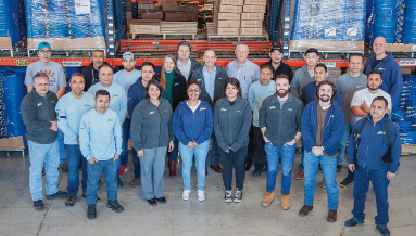 |
| The Alliance team worked together to seamlessly transition through a new module of the company’s ERP, like rebuilding a plane mid-flight, said President Dave Heckler. No wonder he say’s they’re wired for hustle. |
few concurrent projects mapped out for 2023, any one of which would be sufficient for leaders made of lesser stuff. And on top of his business initiatives, the 64-year-old is also being installed as the 39th president of NAHAD – The Association for Hose and
Accessories Distribution in April.
A Busy Year Ahead
Unfortunately, remediating office water damage took top priority by necessity in the first quarter of the new year, but Heckler was relieved that a city permit came through on February 1 so a roof drain diversion plan can finally be executed. That work, plus baseboard and carpet replacement, as well as new plumbing work have caused some temporary distraction from his loftier ambitions, not to mention a very hefty price tag to solve the problem once and for all.
Next on the Alliance itinerary will be a reconfiguration of the building’s current footprint that will push down a wall to expand warehouse storage and production – they’ll gain a few thousand square feet from a large and largely unused space the staff calls “the ballroom.” Finding a new place for employees to eat lunch will be small potatoes when compared with the pricey alternative: Heckler has rejected estimates of $2 million to bump out the back of the warehouse to gain 12,000 square feet.
 |
|
Heckler pauses for conversation out on the floor with Production Manager Greg Lubinski. |
The reno isn’t all he’s tackling. This year, Alliance will roll out an e-commerce dimension to its website, with the chief aim of providing existing customers with online purchasing options. Responding to what he considers one of the major trends of industrial distribution, Heckler recognizes the time is ripe for addressing the preferences of next-generation purchasers in the workforce.
“As customers’ buying habits shift, some of the most reputable hose companies in our industry are adding these website capabilities to serve existing customers and give them the ‘omni channel’ capability,” he said. “So, we too have started on that path. I’ve had some colleagues in the industry that have moved further down the path and have had good success. One thing some have done is list things for sale on their site but at higher list prices – they’re not trying to catch every little piece of business and destroy profit margins.”
Heckler has a track record for keeping up on capital investments for his production operations that will produce good ROI, and in 2023 he’ll continue that pattern, but with a twist. This spring, he’s beginning the exploration and discussions that will lead to Alliance’s first foray into automated guided vehicles (AGVs), which will help relieve some physical strain and steps for the production team.
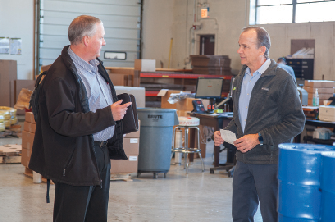 |
|
Sales Manager Rob Wilson (left) is almost always in a hurry to get out the door and see customers. |
“Last fall, I was at a resort hotel for a wedding,” he said. “I was walking from one area into the dining area looking down at my phone and almost tripped over a little AGV thing. Of course, I didn’t trip over it because it stopped for me. It was bringing plates of food from the kitchen to a wait station, and I thought, ‘Wow, that’s saving them a lot of steps.’ And this wasn’t a big fancy hotel, and they weren’t drawing attention to this – it’s just part of how they do business.
“I looked at that and thought, ‘What if we had two or three of those things in staging areas that move from production to shipping – they can move product around as it is finished and bring them over,” Heckler said. “It would save some of the stooping and bending, and would trim off the time lag to make the process more continuous. So, I’m starting that discussion to see how this could work for us.”
Fixing Kinks for Future Growth
One reason Alliance Hose is well positioned for positive changes and a strong outlook for 2023 is that it had the collective courage to press “Pause” and make a process
correction during the frenzied, skyrocketing volumes of 2021-2022. It meant incorporating a never-used feature of their ERP system to remove a bottleneck, but it was nonetheless difficult to achieve, as all work process changes are.
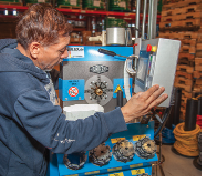 |
|
A worker inputs settings on a crimping machine, one of several on the production floor. |
“It was a little like rebuilding the airplane while it was in flight,” Heckler recalled. “Supply chain issues forced backlogs on us and we had to recreate a flow.”
The company has used the same ERP software since Heckler joined the business in 1994 – a U.S. branch of the South African-based product for manufacturers and distributors, plus a local service provider, have grown and adapted with Alliance through the years, saving them the painful experience of switching to a new system. And until recently, the ERP had met all their needs as a small, single-location operation.
But supply chain disruptions raised issues the ERP wasn’t configured to handle. When material deliveries became inconsistent, the team carried out its proprietary fast turnarounds but the ERP settings they were using didn’t allow the company to invoice multiple shipments for a single order. The team literally had to sit on finished work instead of shipping out completed portions, and that was not sustainable.
“We had to turn on a new mode in the ERP we hadn’t used before; it’s something that a large, multi-location company would use,” said Heckler. “We had actually been telling our people, ‘don’t process that,’ or ‘process it but don’t put it in the computer.’ It was a mess. And changing things mid-flight was a challenge.’
He credits the team of frontline people – comprising of production, shipping, material handling, and sales whose experience ranged from 15 years to less than a year – with achieving the smooth transition. “In two months, without slowing our already frenetic pace of shipping, the team installed the new software and process,” Heckler said. “This increased the throughput of our shipping, allowing us to catch up on backorders faster.”
The hard work done, Heckler sees a bright future for his company even amid economic question marks that hover over the coming year.
“I think we will see high single-digit growth, or maybe low double digits, which is a lot lower than we’ve been seeing,” he said. “Some of that is purely pricing growth – we do see volume growth staying the same or increasing slightly. I think the industry is going to see low single-digit growth, although some areas might be retracting.”
Heckler added that because access to materials and products was unpredictable for such a prolonged period, he expects to see some post-pandemic artificial demand – aka over-buying.
“I call it borrowing from the future,” he said, “because people want to make sure they have what they need for their own production or to supply their customers.”
While uncertainty dominated the market post-lockdown, supply chain snafus created the added byproduct of mediocre customer service throughout the industry, Heckler said.
“Everyone’s gotten used to a compromised level of service all the way through the supply chain because information was bad,” he said. “We want to tighten that up and not get used to the idea that things are going to be three or four weeks late. We’re going to beat our competition to the punch with the right product, the right service, and with the urgency that the customer wants it.”
Customers and the Connection Paradox
Throughout Illinois, Southeast Wisconsin, Northwest Indiana and even up to Southwest Michigan, Alliance Hose serves a customer base comprised of well-known catalog companies or “big box” stores – companies that redistribute Alliance’s hose and related products. This segment of customer tends to have regular, repeating order
patterns of buying with a high focus on cost competitiveness. 
“We’ve designed our processes to be competitive and responsive to their needs, and the timing of their needs,” Heckler said.
The company has also historically maintained healthy construction supply market share, selling hoses to equipment companies that sell pumps, compressors, and consumables to contractors. Regrettably, he added, the OEM market has been deteriorating for decades. “Illinois has done a really good job of driving them out,” he said.
“But there’s plenty of MRO business left,” he added, “and chemical and petroleum packaging and processing are still done around here. Overall, we’re 98% industrial hose and related accessories.”
Food and beverage is a strong customer segment, fed by continuous need as well as reliance on local suppliers. A relatively new niche Alliance is tapping into has become its highest growth area by percentage: breweries and distilleries. Alliance Hose Sales Manager Rob Williams has worked diligently to build up relationships and they’ve sold to over 200 different locations over the last eight years, even as far away as Canada and Hawaii. They’ve become active in the Craft Brewers Association and Williams has positioned himself as a safety expert on the safety committee and by writing for publications.
While that helps get good information into customer hands, it only scratches the surface of a universal and paradoxical problem Alliance’s management sees among end users. On the one hand, customers are harder to get to, often isolating themselves within digital walls. But on the other hand, they’re information-starved, seeking reliable product and safety knowledge yet blocking themselves from the people who can partner and provide solutions they need.
“Everywhere, we are seeing reduced service support, but customers want and need the kind of expertise we provide,” said Heckler. “They’re diverging trends, really: people don’t want to talk to you, but then people really need to talk to you. It can be hard to get through the gate, but when we do, we find how many technical and functional questions they have and how much they really need our knowledge.”
Make No Assumptions
As a distributor who has made a habit of networking and learning at NAHAD, has been active in the IDCO buyers group, and also participates in a peer group called Renaissance Executive Forums, Heckler has been intentional about putting himself where both industry trends and best practices are readily accessible. As
a result, the information he gleans has been vital to many business decisions over his 24-year tenure as president.
From those experiences, he’s confident in urging others to be bold in their own outreach, especially when it comes to staying plugged in with those they do business with.
“Times are really changing now as things go digital, and routes to market are changing,” he said. “Some suppliers may be considering if they should go direct. I think distributors need to stretch out of the comfort zone and communicate with customers with suppliers and say, ‘How are we doing?’ and ‘How can we do this better?’ You can’t just trust everything’s okay and someone’s going to keep buying from you or selling to you. You can’t make that assumption anymore. You’ve got to continue to cultivate those relationships on an ongoing basis.”
This article originally appeared in the March/April 2023 issue of Industrial Supply magazine. Copyright 2023, Direct Business Media.













